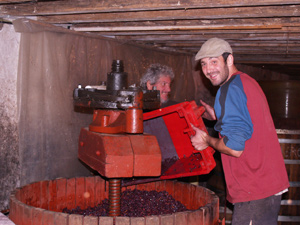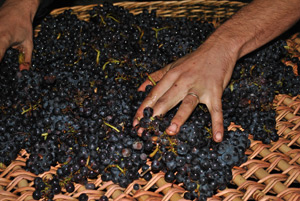

|
Each vintage is different, the winemaker also feels different each year depending on what he has lived throughout the year,
his experiences, people he has met.
With this in mind, some main principals which remain constant:
Grapes are hand-picked and brought to the winery in cases.
No new wood.
Nothing added during winemaking.
The harvest is the result of an enormous amount of work, often quite difficult, which lasts all year long. The grapevine benefits greatly from regular care.
Once it is in the tank, it is really difficult not to intervene. The grapes are there all together and the desire to do something is always present!
One must remain confident, take one’s time and enjoy the wait. It’s important also to reflect on the tiny interventions that must happen, to get them just right,
and to know when to walk away.
White Wines
The Crush: The grapes arrive in cases and are crushed right away.
Débourbage (Clarification): The juice stays in the tank for 24/36 hours,
so that the majority of the sediment may fall to the bottom and collect there.
Barreling: The juice is then transferred by gravity to the cellar, to the 228L barrels.
Fermentation: The wines ferment each according to its own rhythm in barrel. This may take anywhere from 15 days to a year!
Sometimes coming to a halt only to restart in Springtime.
Élevage: After fermentation, the wines clarify while remaining on their lies (fine sediment).
It’s only the pipette (wine theif) who occasionally disturbs the sleeping wine. Depending on the specific wine, élevage may last from 6 months to a year.
Racking: The barrels are emptied, taking care not to disturb the fine sediment in order to keep the wine clear.
Each barrel of wine is reunited in a tank; this is the moment where the wine is liberated. It releases Carbon Dioxide and takes in some Oxygen.
The racking must be done appropriately depending on the individual wine. The wine’s particular expression really comes out during this period.
Bottling: In Springtime and before the harvest
Red Wines
The grapes arrive to the winery in cases.
Partial destemming, from 20 to 50%
Fermentation begins slowly after 5-6 days. At the end of the maceration period, a remontage (bringing the juice from the bottom of the tank up over the grapes on the top)
is carried out to help the fermentation fully begin in earnest.
The tank remains an additional 10-15 days with only 2-to-3 pigeages (the “cap” or surface of grapes is pushed down with bare feet into the fermenting mass)
And finally it’s time to press, using an old-fashioned vertical press.
The resulting wine is put into a tank for 24 hours, and then brought down into the cellar by gravity into the barrels, where it will slowly and at its own pace,
finish to transform the remaining sugars into alcohol.
The wine remains in barrel on its lies (fine sediment) until Summer, eventually to be bottled early September.

